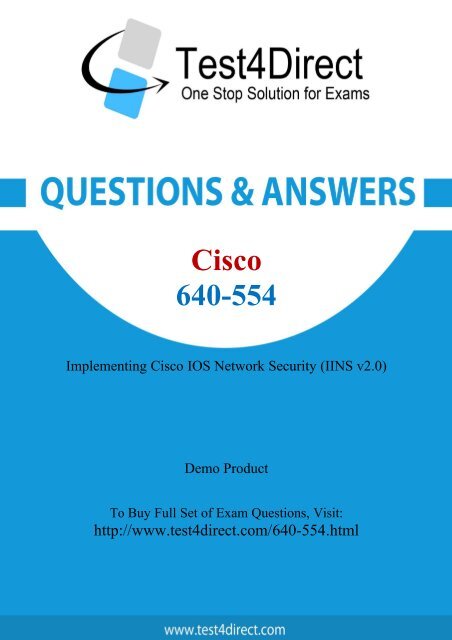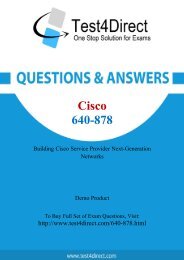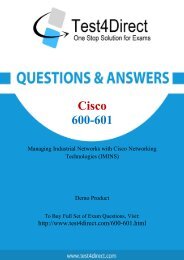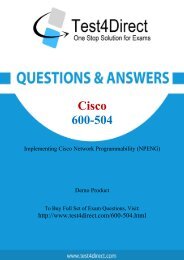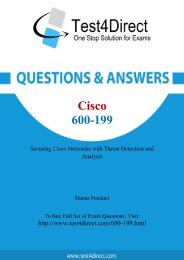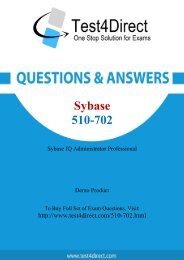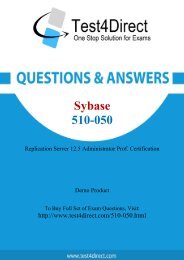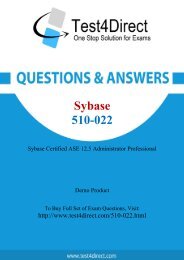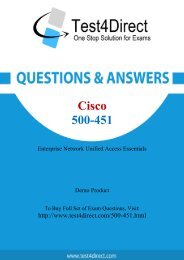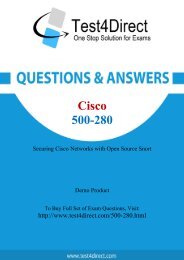640-554-demo
You also want an ePaper? Increase the reach of your titles
YUMPU automatically turns print PDFs into web optimized ePapers that Google loves.
Cisco<br />
<strong>640</strong>-<strong>554</strong><br />
Implementing Cisco IOS Network Security (IINS v2.0)<br />
Demo Product<br />
To Buy Full Set of Exam Questions, Visit:<br />
http://www.test4direct.com/<strong>640</strong>-<strong>554</strong>.html
Question: 1<br />
Which two features are supported by Cisco IronPort Security Gateway? (Choose two.)<br />
A. Spam protection<br />
B. Outbreak intelligence<br />
C. HTTP and HTTPS scanning<br />
D. Email encryption<br />
E. DDoS protection<br />
Question: 2<br />
Answer: A, D<br />
Explanation:<br />
http://www.cisco.com/en/US/pHYPERLINK<br />
"http://www.cisco.com/en/US/prod/collateral/vpndevc/ps10128/ps10154/data-sheet-c78-<br />
729751.html#_blank"rod/collateral/vpndevc/ps10128/ps10154/data-sheet-c78-729751.html<br />
Product Overview<br />
Over the past 20 years, email has evolved from a tool used primarily by technical and research<br />
professionals to become the backbone of corporate communications. Each day, more than 100 billion<br />
corporate email messages are exchanged. As the level of use rises, security becomes a greater<br />
priority. Mass spam campaigns are no longer the only concern. Today, spam and malware are just<br />
part of a complex picture that includes inbound threats and outbound risks.<br />
Cisco® Email Security solutions defend mission-critical email systems with appliance, virtual, cloud,<br />
and hybrid solutions. The industry leader in email security solutions, Cisco delivers:<br />
Fast, comprehensive email protection that can block spam and threats before they even hit your<br />
network<br />
Flexible cloud, virtual, and physical deployment options to meet your ever-changing business needs<br />
Outbound message control through on-device data-loss prevention (DLP), email encryption, and<br />
optional integration with the RSA enterprise DLP solution<br />
One of the lowest total cost of ownership (TCO) email security solutions available<br />
Which two characteristics represent a blended threat? (Choose two.)<br />
A. man-in-the-middle attack<br />
B. trojan horse attack<br />
C. pharming attack<br />
D. denial of service attack<br />
E. day zero attack<br />
Answer: B, E<br />
Explanation:<br />
http://www.cisco.com/web/IN/about/netwHYPERLINK<br />
"http://www.cisco.com/web/IN/about/network/threat_defense.html#_blank"ork/threat_defense.ht<br />
ml
Rogue developers create such threats by using worms, viruses, or application-embedded attacks.<br />
Botnets can be used to seed an attack, for example, rogue developers can use worms or applicationembedded<br />
attacks, that is an attack that is hidden within application traffic such as web traffic or<br />
peer-to-peer shared files, to deposit "Trojans". This combination of attack techniques - a virus or<br />
worm used to deposit a Trojan, for example-is relatively new and is known as a blended attack. A<br />
blended attack can also occur in phases: an initial attack of a virus with a Trojan that might open up<br />
an unsecured port on a computer, disable an access control list (ACL), or disarm antivirus software,<br />
with the goal of a more devastating attack to follow soon after. Host Firewall on servers and<br />
desktops/laptops, day zero protection & intelligent behavioral based protection from application<br />
vulnerability and related flaws (within or inserted by virus, worms or Trojans) provided great level of<br />
confidence on what is happening within an organization on a normal day and when there is a attack<br />
situation, which segment and what has gone wrong and gives flexibility and control to stop such<br />
situations by having linkages of such devices with monitoring, log-analysis and event co-relation<br />
system.<br />
Question: 3<br />
Which two options represent a threat to the physical installation of an enterprise network? (Choose<br />
two.)<br />
A. surveillance camera<br />
B. security guards<br />
C. electrical power<br />
D. computer room access<br />
E. change control<br />
Explanation:<br />
http://www.cisco.com/E-Learning/bulk/public/celc/CRS/media/targets/1_3_1.swf<br />
Question: 4<br />
Question: 5<br />
Answer: C, D<br />
Which option represents a step that should be taken when a security policy is developed?<br />
A. Perform penetration testing.<br />
B. Determine device risk scores.<br />
C. Implement a security monitoring system.<br />
D. Perform quantitative risk analysis.<br />
Which type of security control is defense in depth?<br />
A. threat mitigation<br />
B. risk analysis<br />
C. botnet mitigation<br />
D. overt and covert channels<br />
Answer: D
Question: 6<br />
Answer: A<br />
Explanation:<br />
http://www.cisco.com/en/US/docs/solutions/Enterprise/Security/SAFE_RG/chap1.html<br />
SAFE Design Blueprint<br />
The Cisco SAFE uses the infrastructure-wide intelligence and collaboration capabilities provided by<br />
Cisco products to control and mitigate well-known and zero-day attacks. Under the Cisco SAFE design<br />
blueprints, intrusion protection systems, firewalls, network admission control, endpoint protection<br />
software, and monitoring and analysis systems work together to identify and dynamically respond to<br />
attacks. As part of threat control and containment, the designs have the ability to identify the source<br />
of a threat, visualize its attack path, and to suggest, and even dynamically enforce, response actions.<br />
Possible response actions include the isolation of compromised systems, rate limiting, packet<br />
filtering, and more.<br />
Control is improved through the actions of harden, isolate, and enforce. Following are some of the<br />
objectives of the Cisco SAFE design blueprints:<br />
•Adaptive response to real-time threats—Source threats are dynamically identified and may be<br />
blocked in realtime.<br />
•Consistent policy enforcement coverage—Mitigation and containment actions may be enforced at<br />
different places in the network for defense in-depth.<br />
•Minimize effects of attack—Response actions may be dynamically triggered as soon as an attack is<br />
detected, minimizing damage.<br />
•Common policy and security management—A common policy and security management platform<br />
simplifies control and administration, and reduces operational expense.<br />
DRAG DROP<br />
1. Initiation<br />
2. Acquisition and development<br />
3. Implementation<br />
4. Operations and maintenance<br />
5. Disposition<br />
Answer:<br />
Explanation:<br />
Secure Network Life Cycle
By framing security within the context of IT governance, compliance, and risk management, and by<br />
building it with a sound security architecture at its core, the result is usually a less expensive and<br />
more effective process. Including security early in the information process within the system design<br />
life cycle (SDLC) usually results in less-expensive and more-effective security when compared to<br />
adding it to an operational system.<br />
A general SDLC includes five phases:<br />
1. Initiation<br />
2. Acquisition and development<br />
3. Implementation<br />
4. Operations and maintenance<br />
5. Disposition<br />
Each of these five phases includes a minimum set of security steps that you need to follow to<br />
effectively incorporate security into a system during its development. An organization either uses the<br />
general SDLC or develops a tailored SDLC that meets its specific needs. In either case, the National<br />
Institute of Standards and Technology (NIST) recommends that organizations incorporate the<br />
associated IT security steps of this general SDLC into their development process.<br />
Question: 7<br />
DRAG DROP<br />
Answer:<br />
Question: 8<br />
Which four methods are used by hackers? (Choose four.)<br />
A. footprint analysis attack<br />
B. privilege escalation attack<br />
C. buffer Unicode attack<br />
D. front door attacks<br />
E. social engineering attack<br />
F. Trojan horse attack
Question: 9<br />
Answer: A, B, E, F<br />
Explanation:<br />
https://learningnetwork.cisco.com/servlet/JiveServlet/download/15823 -1-<br />
57665/CCNA%20Security%20(<strong>640</strong>-<strong>554</strong>)%20Portable%20Command%20Guide_ch01.pdf<br />
Thinking Like a Hacker<br />
The following seven steps may be taken to compromise targets and applications:<br />
Step 1 Perform footprint analysis<br />
Hackers generally try to build a complete profile of a target company’s security posture using a broad<br />
range of easily available tools and techniques. They can discover organizational domain names,<br />
network blocks, IP addresses of systems, ports, services that are used, and more.<br />
Step 2 Enumerate applications and operating systems<br />
Special readily available tools are used to discover additional target information. Ping sweeps use<br />
Internet Control Message Protocol (ICMP) to discover devices on a network. Port scans discover<br />
TCP/UDP port status.<br />
Other tools include Netcat, Microsoft EPDump and Remote Procedure Call (RPC) Dump, GetMAC,<br />
and software development kits (SDKs).<br />
Step 3 Manipulate users to gain access<br />
Social engineering techniques may be used to manipulate target employees to acquire passwords.<br />
They may call or email them and try to convince them to reveal passwords without raising any<br />
concern or suspicion.<br />
Step 4 Escalate privileges<br />
To escalate their privileges, a hacker may attempt to use Trojan horse programs and get target users<br />
to unknowingly copy malicious code to their corporate system.<br />
Step 5 Gather additional passwords and secrets<br />
With escalated privileges, hackers may use tools such as the pwdump and LSADump applications to<br />
gather passwords from machines running Windows.<br />
Step 6 Install back doors<br />
Hacker may attempt to enter through the “front door,” or they may use “back doors” into the system.<br />
The backdoor method means bypassing normal authentication while attempting to remain<br />
undetected. A common backdoor point is a listening port that provides remote access to the system.<br />
Step 7 Leverage the compromised system<br />
After hackers gain administrative access, they attempt to hack other systems.<br />
Which characteristic is the foundation of Cisco Self-Defending Network technology?<br />
A. secure connectivity<br />
B. threat control and containment<br />
C. policy management<br />
D. secure network platform<br />
Answer: D<br />
Explanation:<br />
http://www.cisco.com/en/US/solutions/ns170/networking_solutions_products_genericcontent0900<br />
aecd8051HYPERLINK<br />
"http://www.cisco.com/en/US/solutions/ns170/networking_solutions_products_genericcontent090<br />
0aecd8051f378.html#_blank"f378.html
Create a Stronger Defense Against Threats<br />
Each day, you reinvent how you conduct business by adopting Internet-based business models. But<br />
Internet connectivity without appropriate security can compromise the gains you hope to make. In<br />
today's connected environment, outbreaks spread globally in a matter of minutes, which means your<br />
security systems must react instantly.<br />
Maintaining security using tactical, point solutions introduces complexity and inconsistency, but<br />
integrating security throughout the network protects the information that resides on it.<br />
Three components are critical to effective information security:<br />
• A secure network platform with integrated security to which you can easily add advanced security<br />
technologies and services<br />
• Threat control services focused on antivirus protection and policy enforcement that continuously<br />
monitor network activity and prevent or mitigate problems<br />
• Secure communication services that maintain the privacy and confidentiality of sensitive data,<br />
voice, video, and wireless communications while cost-effectively extending the reach of your<br />
network<br />
Question: 10<br />
In a brute-force attack, what percentage of the keyspace must an attacker generally search through<br />
until he or she finds the key that decrypts the data?<br />
A. Roughly 50 percent<br />
B. Roughly 66 percent<br />
C. Roughly 75 percent<br />
D. Roughly 10 percent<br />
Question: 11<br />
Question: 12<br />
Answer: A<br />
Which three items are Cisco best-practice recommendations for securing a network? (Choose three.)<br />
A. Routinely apply patches to operating systems and applications.<br />
B. Disable unneeded services and ports on hosts.<br />
C. Deploy HIPS software on all end-user workstations.<br />
D. Require strong passwords, and enable password expiration.<br />
Answer: A, B, D<br />
What Cisco Security Agent Interceptor is in charge of intercepting all read/write requests to the rc<br />
files in UNIX?<br />
A. Configuration interceptor<br />
B. Network interceptor<br />
C. File system interceptor<br />
D. Execution space interceptor
Question: 13<br />
Answer: A<br />
Explanation<br />
Configuration interceptor: Read/write requests to the Registry in Windows or to rc configuration files<br />
on UNIX are intercepted. This interception occurs because modification of the operating system<br />
configuration can have serious consequences. Therefore, Cisco Security Agent tightly controls<br />
read/write requests to the Registry.<br />
Information about a managed device’s resources and activity is defined by a series of objects. What<br />
defines the structure of these management objects?<br />
A. MIB<br />
B. FIB<br />
C. LDAP<br />
D. CEF<br />
Question: 14<br />
Question: 15<br />
Answer: A<br />
Explanation<br />
Management Information Base (MIB) is the database of configuration variables that resides on the<br />
networking device.<br />
Which statement is true about vishing?<br />
A. Influencing users to forward a call to a toll number (for example, a long distance or international<br />
number)<br />
B. Influencing users to provide personal information over a web page<br />
C. Using an inside facilitator to intentionally forward a call to a toll number (for example, a long<br />
distance or international number)<br />
D. Influencing users to provide personal information over the phone<br />
Answer: D<br />
Explanation:<br />
Vishing (voice phishing) uses telephony to glean information, such as account details, directly from<br />
users. Because many users tend to trust the security of a telephone versus the security of the web,<br />
some users are more likely to provide confidential information over the telephone. User education is<br />
the most effective method to combat vishing attacks.<br />
Which item is the great majority of software vulnerabilities that have been discovered?<br />
A. Stack vulnerabilities<br />
B. Heap overflows
C. Software overflows<br />
D. Buffer overflows<br />
Answer: D<br />
Question: 16<br />
Which one of the following items may be added to a password stored in MD5 to make it more<br />
secure?<br />
A. Ciphertext<br />
B. Salt<br />
C. Cryptotext<br />
D. Rainbow table<br />
Question: 17<br />
Which option is a feature of Cisco ScanSafe technology?<br />
A. spam protection<br />
B. consistent cloud-based policy<br />
C. DDoS protection<br />
D. RSA Email DLP<br />
Answer: B<br />
Answer: B<br />
Explanation:<br />
http://www.cisco.com/en/US/prod/collateral/vpndevc/ps6525/ps6538/ps6540/data_sheet_c78 -<br />
6HYPERLINK<br />
"http://www.cisco.com/en/US/prod/collateral/vpndevc/ps6525/ps6538/ps6540/data_sheet_c78 -<br />
655324.html#_blank"55324.html<br />
Cisco Enterprise Branch Web Security<br />
The Cisco® Integrated Services Router G2 (ISR G2) Family delivers numerous security services,<br />
including firewall, intrusion prevention, and VPN. These security capabilities have been extended<br />
with Cisco ISR Web Security with Cisco ScanSafe for a simple, cost-effective, on-demand web security<br />
solution that requires no additional hardware. Organizations can deploy and enable market-leading<br />
web security quickly and easily, and can enable secure local Internet access for all sites and users,<br />
saving bandwidth, money, and resources.<br />
Figure 1. Typical Cisco ISR Web Security with Cisco ScanSafe Deployment
Cisco ISR Web Security with Cisco ScanSafe enables branch offices to intelligently redirect web traffic<br />
to the cloud to enforce granular security and control policy over dynamic Web 2.0 content,<br />
protecting branch office users from threats such as Trojans, back doors, rogue scanners, viruses, and<br />
worms. The Cisco ISR Web Security with Cisco ScanSafe feature will be available in the Security SEC<br />
K9 license bundle<br />
Question: 18<br />
Refer to the exhibit.<br />
What does the option secret 5 in the username global configuration mode command indicate about<br />
the user password?<br />
A. It is hashed using SHA.<br />
B. It is encrypted using DH group 5.<br />
C. It is hashed using MD5.<br />
D. It is encrypted using the service password-encryption command.<br />
E. It is hashed using a proprietary Cisco hashing algorithm.<br />
F. It is encrypted using a proprietary Cisco encryption algorithm.<br />
Question: 19<br />
Answer: C<br />
Explanation:<br />
http://www.cisco.com/en/US/docs/ios/12_0s/feature/guide/120s_md5.html<br />
Feature Overview<br />
Using the Enhanced Password Security feature, you can configure MD5 encryption for username<br />
passwords.<br />
Before the introduction of this feature there were two types of passwords associated with<br />
usernames. Type 0 is a clear text password visible to any user who has access to privileged mode on<br />
the router. Type 7 is a password with a weak, exclusive-or type encryption. Type 7 passwords can be<br />
retrieved from the encrypted text by using publicly available tools.<br />
MD5 encryption is a one-way hash function that makes reversal of an encrypted password<br />
impossible, providing strong encryption protection. Using MD5 encryption, you cannot retrieve clear<br />
text passwords. MD5 encrypted passwords cannot be used with protocols that require that the clear<br />
text password be retrievable, such as Challenge Handshake Authentication Protocol (CHAP).<br />
Use the username (secret) command to configure a user name and an associated MD5 encrypted<br />
secret.<br />
Configuring Enhanced Security Password<br />
Router(config)# username name secret 0 password<br />
Configures a username and encrypts a clear text password with MD5 encryption.<br />
or<br />
Router(config)# username name secret 5 encrypted-secret<br />
Configures a username and enters an MD5 encrypted text string which is stored as the MD5<br />
encrypted password for the specified username.
What does level 5 in this enable secret global configuration mode command indicate?<br />
router#enable secret level 5 password<br />
A. The enable secret password is hashed using MD5.<br />
B. The enable secret password is hashed using SHA.<br />
C. The enable secret password is encrypted using Cisco proprietary level 5 encryption.<br />
D. Set the enable secret command to privilege level 5.<br />
E. The enable secret password is for accessing exec privilege level 5.<br />
Question: 20<br />
Answer: D<br />
Explanation:<br />
http://www.cisco.com/en/US/docs/ios/12_2/security/configuration/guide/scfpass.html<br />
To configure the router to require an enable password, use either of the following commands in<br />
global configuration mode:<br />
Router(config)# enable password [level level] {password| encryption-type encrypted-password}<br />
Establishes a password for a privilege command mode.<br />
Router(config)# enable secret [level level] {password | encryption-type encrypted-password}<br />
Specifies a secret password, saved using a non-reversible encryption method. (If enable password<br />
and enable secret are both set, users must enter the enable secret password.)<br />
Use either of these commands with the level option to define a password for a specific privilege<br />
level.<br />
After you specify the level and set a password, give the password only to users who need to have<br />
access at this level. Use the privilege level configuration command to specify commands accessible<br />
at various levels.<br />
Which option is the correct representation of the IPv6 address<br />
2001:0000:150C:0000:0000:41B1:45A3:041D?<br />
A. 2001::150c::41b1:45a3:041d<br />
B. 2001:0:150c:0::41b1:45a3:04d1<br />
C. 2001:150c::41b1:45a3::41d<br />
D. 2001:0:150c::41b1:45a3:41d<br />
Answer: D<br />
Explanation:<br />
http://www.cisco.com/web/strategy/docs/gov/IPv6_WP.pdf<br />
Address Representation<br />
The first area to address is how to represent these 128 bits. Due to the size of the numbering space,<br />
hexadecimal numbers and colons were chosen to represent IPv6 addresses. An example IPv6 address<br />
is:<br />
2001:0DB8:130F:0000:0000:7000:0000:140B<br />
Note the following:<br />
•There is no case sensitivity. Lower case “a” means the same as capital “A”.<br />
•There are 16 bits in each grouping between the colons.<br />
– 8 fields * 16 bits/field = 128 bits
There are some accepted ways to shorten the representation of the above address:<br />
•Leading zeroes can be omitted, so a field of zeroes can be represented by a single 0.<br />
•Trailing zeroes must be represented.<br />
•Successive fields of zeroes can be shortened down to “::”. This shorthand representation can only<br />
occur once in the address.<br />
Taking these rules into account, the address shown above can be shortened to:<br />
2001:0DB8:130F:0000:0000:7000:0000:140B<br />
2001:DB8:130F:0:0:7000:0:140B (Leading zeroes)<br />
2001:DB8:130F:0:0:7000:0:140B (Trailing zeroes)<br />
2001:DB8:130F::7000:0:140B (Successive field of zeroes)
THANKS FOR TRYING THE DEMO OF OUR PRODUCT<br />
Visit Our Site to Purchase the Full Set of Actual <strong>640</strong>-<strong>554</strong> Exam Questions With Answers.<br />
http://www.test4direct.com/<strong>640</strong>-<strong>554</strong>.html<br />
We Also Provide Practice Exam Software That Simulates Real Exam Environment And Has<br />
Many Self-Assessment Features. Download Free Product Demo From:<br />
http://www.test4direct.com/<strong>640</strong>-<strong>554</strong>.html<br />
Money Back Guarantee<br />
Check Out Our Customer Testimonials


